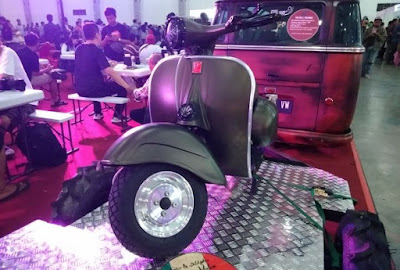American cars have a long and rich tradition both in the United States and around the world. This proves that it is true that the United States could be said to be the motorized vehicles paradise. Not only famous for the American muscle cars, they are also famous for the classic cars.
 |
| Most spectacular concept car of the decade, the 1995 Chrysler Atlantic. (Picture from: http://bit.ly/2J9CXit) |
If you ask why that was chosen in the 1990s, because in that time span many unique concept cars were born from the American automotive industry.
Here are the first row of 8 unique concept cars made in America in the 1990s:
1. 1994 Chrysler Aviat
 Based on the Dodge/Plymouth Neon, the Aviat concept was a computer generated creation for a 21st century sports coupe with excellent coefficient of drag. Power was supplied by a DOHC 16-valve 2.0-liter inline 4-cylinder that produced 145 horses, and although the engine was front-mounted, the cooling system was repositioned within the outrigger-style rear-quarter fenders.
Based on the Dodge/Plymouth Neon, the Aviat concept was a computer generated creation for a 21st century sports coupe with excellent coefficient of drag. Power was supplied by a DOHC 16-valve 2.0-liter inline 4-cylinder that produced 145 horses, and although the engine was front-mounted, the cooling system was repositioned within the outrigger-style rear-quarter fenders. |
| 1994 Chrysler Aviat. (Picture from: http://bit.ly/2NZ5fwW) |
2. 1995 Chrysler Atlantic
One of the most beautiful of recent concept cars, the Chrysler Atlantic recalled the styling of the classic Bugatti grand tourer of the same name. With its sculpted body, the Atlantic wore huge chrome wheels, and was powered by a straight-eight engine that was constructed with two Chrysler Neon fours.
 |
| 1995 Chrysler Atlantic. (Picture from: http://bit.ly/2CzPf2z) |
3. 1995 Ford GT90
 There were several efforts within Ford to create a successor to the GT40 that won Le Mans. One of those was the GT90, which showcased the “New Edge” design language popular within Ford’s styling studio. And then Ford made a dramatic reveal at the Detroit Auto Show. Dressed in white, the new 1995 Ford GT90 concept car. For a brief amount of time after its unveiling, the entire automotive industry was abuzz about what was then the world’s fast and most powerful car.
There were several efforts within Ford to create a successor to the GT40 that won Le Mans. One of those was the GT90, which showcased the “New Edge” design language popular within Ford’s styling studio. And then Ford made a dramatic reveal at the Detroit Auto Show. Dressed in white, the new 1995 Ford GT90 concept car. For a brief amount of time after its unveiling, the entire automotive industry was abuzz about what was then the world’s fast and most powerful car. |
| 1995 Ford GT90. (Picture from: http://bit.ly/2CX1x5Q) |
4. 1996 Ford Synergy
 The Synergy 2010 was Ford’s idea of in 1996. As such, it featured two power sources — a 1.0-litre direct-injection extremely lightweight materials (it weighed just one tonne (ton)), "air fences", which dictated the car’s advanced, aerodynamic styling and computer-animated instruments. You could even call up the phone book by issuing a simple verbal command!
The Synergy 2010 was Ford’s idea of in 1996. As such, it featured two power sources — a 1.0-litre direct-injection extremely lightweight materials (it weighed just one tonne (ton)), "air fences", which dictated the car’s advanced, aerodynamic styling and computer-animated instruments. You could even call up the phone book by issuing a simple verbal command! |
| 1996 Ford Synergy. (Picture from: http://bit.ly/2CwI6jh) |
The first part of Row of unique 1990s American concept cars is stoped here and will continue on the next section. (Jump to Part-2.) *** [EKA | FROM VARIOUS SOURCES | THE CLASSIC CARS JOURNAL]
Note: This blog can be accessed via your smart phone



































